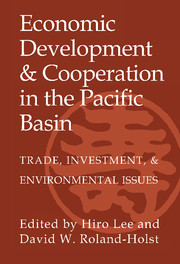 Economic Development and Cooperation in the Pacific Basin
Economic Development and Cooperation in the Pacific Basin Published online by Cambridge University Press: 19 May 2010
INTRODUCTION
Interdependence among countries has increased substantially since the end of World War II. The main force behind this growing interdependence is international trade. Indeed, it is the rapid expansion in world trade, resulting largely from liberalization of manufacturing trade, that has led to substantial growth of the world economy. In recent years, however, foreign direct investment (FDI) has become a major contributor to deepening interdependence among countries. Between 1980 and 1996, world FDI grew at an annual average rate of 12.6 percent, significantly higher than the corresponding growth rate of 6.5 percent for world trade (both in nominal terms).
Rapid FDI expansion has given rise to an important and interesting question regarding the relationship between FDI and international trade. Does international trade promote or discourage FDI? Does FDI facilitate or restrict international trade? These questions concern whether FDI and trade are complements or substitutes (i.e., whether they exert positive or negative influences on each other).
Theoretically, FDI and trade can be either complements or substitutes. Within the framework of the Heckscher-Ohlin (H-O) model, Mundell (1957) showed that FDI and trade are perfect substitutes; in other words, trade reduces incentives for FDI and vice versa. In contrast, by relaxing the assumptions used in the H-O model, Markusen (1983) obtained a case where FDI and trade can be complements. Specifically, he demonstrated that FDI expands trade when trade is induced by non-H-O factors, such as differences in technologies between trading partners. A crucial determinant of this relationship is whether FDI is undertaken in an export industry or import-competing industry in the host country.
To save this book to your Kindle, first ensure [email protected] is added to your Approved Personal Document E-mail List under your Personal Document Settings on the Manage Your Content and Devices page of your Amazon account. Then enter the ‘name’ part of your Kindle email address below. Find out more about saving to your Kindle.
Note you can select to save to either the @free.kindle.com or @kindle.com variations. ‘@free.kindle.com’ emails are free but can only be saved to your device when it is connected to wi-fi. ‘@kindle.com’ emails can be delivered even when you are not connected to wi-fi, but note that service fees apply.
Find out more about the Kindle Personal Document Service.
To save content items to your account, please confirm that you agree to abide by our usage policies. If this is the first time you use this feature, you will be asked to authorise Cambridge Core to connect with your account. Find out more about saving content to Dropbox.
To save content items to your account, please confirm that you agree to abide by our usage policies. If this is the first time you use this feature, you will be asked to authorise Cambridge Core to connect with your account. Find out more about saving content to Google Drive.